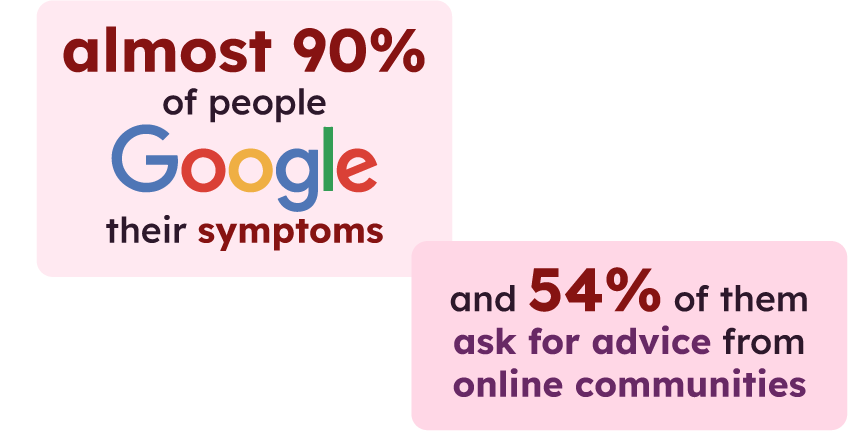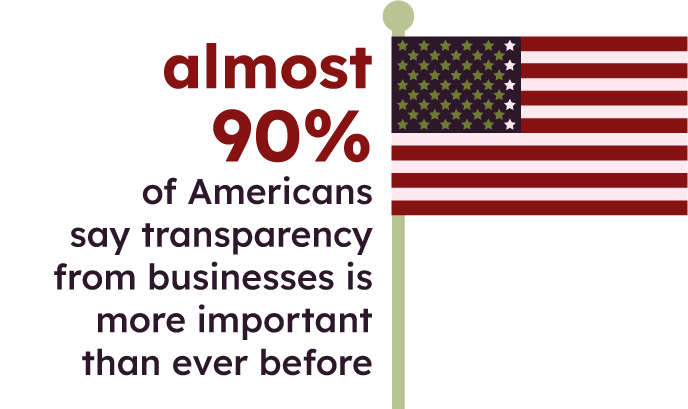While the live doctor-patient interaction remains irreplaceable, the path leading to it has been shaped by the constant influence of the internet in the past decade or two. With almost 90% of people Googling their symptoms, followed by 54% of them asking for advice from online communities, the question surrounding the role of social media in healthcare has shifted from why to how.
Patients are becoming more self-aware, making the surge in social media use for healthcare discussions undeniable. At the same time, embracing this digital evolution is a chance for you to relate to patients in innovative ways, adapting to the evolving patterns of interaction.
However, the sensitivity of data, such as protected health information (PHI), may come as an obstacle for those who want to promote their healthcare practice through social media. That’s where different marketing strategies designed to enhance patient engagement and public outreach come in while allowing you to stay aligned with HIPAA compliance.
In response to the increasing dependence of patients on these platforms for reliable healthcare opinions, you need to adapt strategies and meet their expectations. That brings us to another important question—how can you establish a clear and trustworthy presence on social media?
Speak In Your Own Style
Using social media in healthcare for promotion starts with your Tone of Voice (ToV), a distinctive way you express yourself as a brand through communication. This includes the personality, style, and attitude conveyed through the messaging.
It may sound abstract, but here’s the simple way to understand it: choose a reputable and trusted brand that has earned your loyalty and pick a few of its public messages, such as social media posts or blogs. While reading you will notice that the messages you’ve chosen are presented in the same unique tone, reflecting the brand’s values—that’s the ToV we talk about. Next, analyze it a bit and write down three things that stand out to you. This reverse-engineering technique can help you clarify the direction you want to take with your ToV and spark inspiration for its development.
Crafting a distinctive ToV means docking it in your healthcare mission and drawing inspiration from your patients’ needs to build authenticity. Your ToV should align with your audience’s attributes to achieve a more impactful connection and lay the foundation for a memorable healthcare brand.
Don’t forget that how you say something is as important as what you say: your tone can help build higher brand awareness among your audience. For your message to both inform and make a connection with your patients, adjust the ToV to resonate with their specific needs.
Clarity Eases The Pain
In healthcare, the importance of clear communication can’t be overstated. If it’s clear, authoritative, and reliable, your messaging can directly affect the positive change in the behavior of your patients while harnessing the benefits of social media in healthcare at the same time.
One of the crucial steps in initiating that change comes from the language you use. While it’s natural for you as a healthcare provider to use medical terms, remember your audience comes from diverse backgrounds seeking simple answers to complex questions. Adapting your vocabulary to be patient-friendly not only reduces the risk of misunderstandings but also spares you from the need for additional explanations.
Use patient feedback to run a simple test to check your clarity. If the same questions or doubts persist on a specific topic in your communication, your clarity needs more sharpening.
Communication has an ethical component, too. In an era where alternative medicine and misinformation about health are flooding the Internet, being clear becomes more than a safeguard for your reputation—it’s a powerful weapon against the fake news havoc in the healthcare domain.
Find Your Audience
As the global count of social media users climbs to an astounding 5 billion worldwide, it’s safe to say that your desired audience can be, quite literally, everywhere. In other words, the target audience on social media in healthcare must be chosen with high precision. Otherwise, it will cost you money and time.
Begin by defining who you want to connect with and then align your distinctive care with the specific needs of your audience. As you then develop a social media marketing strategy, consider where your target audience is active and make sure your message is visible where it matters most. For example, suppose your clinic offers sports medicine services. In that case, you might target athletes and sports enthusiasts, focusing on platforms frequently used by this demographic, like fitness-related YouTube channels or health-focused Facebook groups.
One more important step for utilizing the potential of audience targeting is to put the patient at the center of every piece of your communication. Building your content based on patients’ needs and behaviors helps you create a more focused and effective social media presence, allowing your message to reach the right ears and resonate deeply with patients’ concerns.
Amplify Your Voice
You’ve identified your ideal audience and tailored your messaging; now it’s time to maximize your reach. Although broad demographic and geographic trends can be helpful in the beginning, partnering with a HIPAA-compliant platform can provide much more valuable long-term results. These platforms utilize advanced data modeling techniques to identify patients in need of specific services, allowing you to refine your approach through predictive patient targeting.
With this data at your disposal, predictive patient targeting allows for clear, simplified messaging and increased patient conversion. To optimize performance, create marketing campaigns for different service lines and adapt your messaging to that specific audience, always staying in line with your ToV. This customization even enables you to promote a variety of services—from knee surgery targeted at athletes or elders to potential patients near a new arthroscopy clinic—in a way that appeals to each target group. This form of predictive patient targeting has put healthcare organizations in a position to optimize their patient mix and maximize their revenue. To see an example of patient targeting in action, read about Desert Orthopaedic Center’s strategy.
Using HIPAA-compliant tools for the implementation of custom healthcare marketing strategies ensures that you stay in line with the regulatory standards, providing you with insights into the performance of your practice and patient interactions.
Put Trust In The Spotlight
 Trust forms the base of every relationship, and it’s no different when it comes to social media in healthcare.
Trust forms the base of every relationship, and it’s no different when it comes to social media in healthcare.
As the digital age takes the stage, people actively seek and engage with health information, expecting healthcare providers to be more focused on them individually. In such a dynamic climate, the old perspectives on trust should be reconsidered and harmonized with the healthcare demands of today. To build and maintain trust online, especially in healthcare, it’s crucial to follow a clear, structured approach. This means using specific, proven strategies that establish trust and strengthen it continuously.
Be Transparent And Authentic
Numbers say it all—almost 90% of Americans say transparency from businesses is more important than ever before, leaving no space to question why making a transparent online environment matters, particularly when it comes to using social media in healthcare.
The effective trick to transparency is storytelling—a unique human talent that shapes opinions and influences behavior. Share behind-the-scenes glimpses of your practice, introduce staff members, and present your commitment to patient care to create a truthful, nothing-to-hide effect, and infuse confidence in your patients. Also, in a time where almost half of the internet is run by bots, this helps you humanize your practice by showing empathy and devotion.
Q&A sessions are another great approach to building transparency. They bring three key benefits together—showing your dedication to patients’ problems, building a unique knowledge base, and reducing time consumption by addressing frequently asked questions only once..
Praise The Reviews
Healthcare stands out as one of the leading industries where consumers consider reviews important to their decision-making. This comes as no surprise, knowing nothing is as crucial as our health. It’s easy to take a gamble with clothing or accessories, but we can’t afford mistakes when it comes to our health and well-being. For that reason, online reviews can play a crucial role in building trust via social media channels in healthcare.
Treating reviews as bare ratings and comments reduces their actual value. They represent the results of your patient engagement, showing patient loyalty, satisfaction, and confidence in your brand. Diving into reviews allows you to uncover the habits of your audience and helps you optimize your processes to address the specific needs of your patients.
Apart from acknowledging positive reviews, you need to pay equal, if not greater, attention to negative feedback. Addressing them shows your integrity and responsibility. Minimizing the impact of negative online reviews and turning them in your favor by addressing the publicly posted negative online reviews and acting upon that feedback to improve your patients’ experience protects your reputation and highlights your professionalism.
Know Your Boundaries
 The possibilities of social media in healthcare appear boundless. Yet, every healthcare provider should recognize the limits imposed by specific rules.
The possibilities of social media in healthcare appear boundless. Yet, every healthcare provider should recognize the limits imposed by specific rules.
The only legal way to protect the privacy and security of patients’ data is through signing a Business Associate Agreement (BAA) with every collaborating entity. Still, some social media platforms, such as Facebook, don’t comply with HIPAA, so your effort to sign a BAA with them will be worthless. That doesn’t relieve you from the responsibility—you are always obliged to do everything in your power to ensure strict adherence to HIPAA rules.
So, to effectively promote your practice while staying within the limits of HIPAA compliance, it’s essential to follow guidelines that ensure the safe posting of information online while safeguarding patient privacy.
Maximize Your Engagement with Social Media in Healthcare
Using social media in healthcare marketing demands significant commitment and planning, with HIPAA compliance obligations lurking in the shadows. That may be discouraging for many healthcare professionals, already immersed in demanding and time-consuming work.
However, you can easily overcome these challenges with a strategic and well-guided approach. Plus, the absence of active involvement in the online community leaves you at its margins, missing the chance to establish your healthcare practice as a trustworthy authority in an increasingly online-driven world.
With SocialClimb’s comprehensive healthcare marketing platform, you can benefit from different digital opportunities and enhance your overall online presence and engagement strategies while ensuring constant adherence to HIPAA compliance. You gain access to advanced features that streamline your healthcare marketing management, enhance patient engagement and high-value patient targeting, and provide insightful analytics to measure your impact. From optimizing your online visibility to managing patient feedback effectively, SocialClimb equips you with everything you need to grow your healthcare organization and stay at the forefront of the industry.
As one modern saying goes — social media is the world’s greatest phonebook. So, why not be easily found and actively engaged in building your public image?











